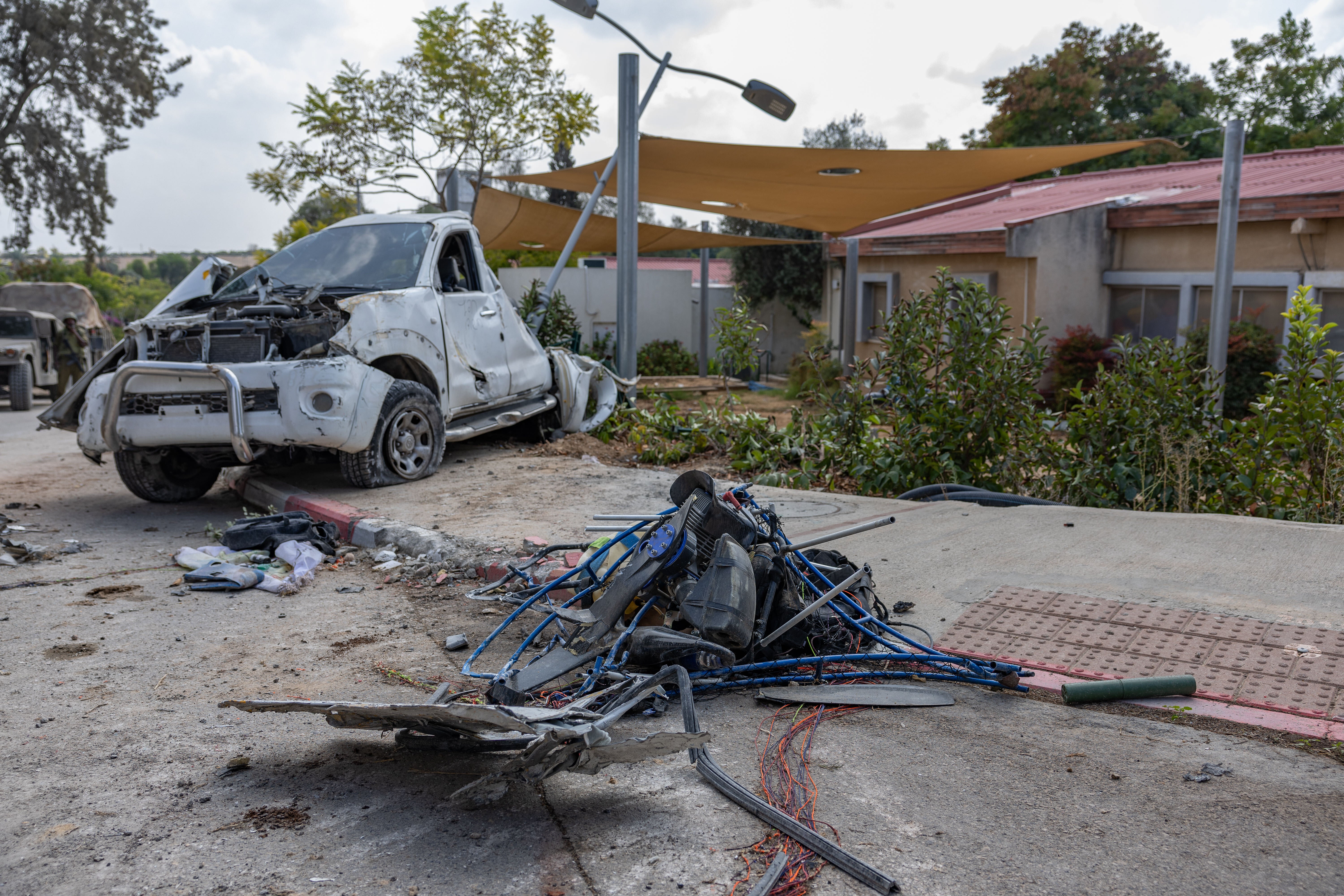‘Kfar Aza smells of death’: Inside the Israeli border village where ‘babies were slaughtered’ in Hamas attack
Warning: Distressing content ‘When Hamas came they cut the heads of women and children,’ an Israeli major claims while making a chopping motion towards his neck, writes Bel Trew. The bodies are hidden so it’s impossible to verify, but it is clear much blood has been shed in the village near the Gaza border


The Israeli village smells of death. The air is thick with the scent of bodies decomposing in the sunshine.
A stutter of machine-gun fire erupts as we first enter Kfar Aza, located a few miles from the border fence with Gaza.
Israeli soldiers, some flat to the ground, fan out silently in a staggered Z-shape. They edge steadily forward through a field, while rocket fire burns lines through the sky above us.
“When Hamas came here they cut the heads of women, they cut the heads of children,” says Major David Ben Zion, while making a chopping motion towards his neck. “We saw dead babies, girls”. The 37-year-old is a reservist deployed here on Saturday to try to evacuate the few survivors of the onslaught. The Independent did not see evidence of his claims.

Watch the full episode on Independent TV here
“We succeeded in saving some of them but we found most dead in their houses,” he adds as soldiers in masks pack the corpses of slain civilians into body bags behind him.
“They came with just one mission to kill more and more of our people.”
After four days of street battles with Hamas militants, the Israeli military has said it is “more or less” in control of the border regions.
But here, in one of the first neighbourhoods to be breached in Saturday’s unprecedented attack, lone gunmen are apparently still left. The gunfire sounds like a desperate last stand.
The rocket fire is also constant. There is no warning as we are so close to the rocket launch pads. The booms shake your chest as they chisel into the ground or erupt above us, intercepted by Israel’s Iron Dome air defence system.

“You can see the blood and carnage everywhere, even on baby carriers,” says Major Doron Speilman, just before we dive for cover. “How can anyone shed their humanity to such a degree?”
The task now is to retrieve the dead. Soldiers are busy pulling bodies of local residents out of booby-trapped houses.
They have chosen to leave the militants, however, stretched out obscenely along the ground. Most are wearing trainers and tracksuit bottoms, with ammunition belts and vests loaded with grenades strapped to their chests.
And so the village is a chilling tableau of what happened on Saturday when the militants broke the border fence in 80 different points and attacked from air, sea and land. Intermingled with shot-up cars, blood-spattered strollers, and spent ammo casings, are the mangled remains of Hamas’s homemade paragliders.

Just in front of the breached fence is a destroyed motorcycle with a Gaza number plate wedged under a car. A metal sign tied to the back reads “Khalas Waqtak’’ in Arabic, which means “your time is up”.
Terrified families were in some instances smoked out of their homes or shelters. Among the dead are several children. Inside one deserted home, is a pool of blood next to a bloodstained rag, implying someone potentially survived.
“If you don’t see signs of a dead body here, then you know the owner was probably kidnapped to Gaza,” one soldier tells me with a shrug.
None of the units know exactly how many people were killed here or how many have been taken hostage in Gaza. In total 130 people, including British and American citizens, women and children, are believed to be in Hamas’s hands. The Israelis collect and note the dead in front of us: these bodies may increase the death toll, which is already more than 1,000.
The militants who tore through this area made it as far as Sderot, a city which is five miles down the road. There, they managed to commandeer a police station for nearly 24 hours, engaging in constant gun battles with Israeli security forces

“How did this happen? We are so angry, we have so many questions,” says Michel Ohayon, 56, an invalid, from his home which is located just a few yards from the police station. Militants knocked on his door on Saturday morning and tried to force him out. Powerless, he watched them slaughter multiple women and police officers, he knew personally, on his doorstep.
“How can it be that the terrorists made it all this way to Sderot?” He asks again in disbelief.
And it is these scenes which are galvanising resolve here in Israel. Rabbi David Fendel, who is delivering aid to Michel, says there can be no peace now. “We have to keep bombing until they can’t lift their heads,” he adds.

Back in Kfar Aza, the soldiers seem to agree.
Gaza, choked by smoke, stretches out against the horizon just a few miles behind the village. Israeli warplanes are relentlessly pounding the 26-mile strip, strikes which have killed more than 800 Palestinians including 90 children. Prime minister Benjamin Netanyahu vowed in a fiery statement this week that the bombardment of Gaza will “reverberate with [our enemies] for generations”.
To pile on further pressure, Israeli defence minister Yoav Gallant also declared a “total siege” on the strip, an act human rights groups said would amount to collective punishment and may violate international law. There are concerns a total blockade will spark a devastating humanitarian catastrophe for the more than two million people who live in the strip. Almost half of them are children.
“No power, no food, no gas, everything is closed,” Gallant said. “We are fighting human animals and we act accordingly.”
The soldiers and residents here say Hamas brought this on themselves because of these barbaric attacks. And so all must be held responsible.
“They aren’t warriors, this wasn’t a war, this was a criminal terrorist attack,” says Major General Itai Verve, as his unit continues to go door-to-door looking for militants in the background.
“We will fight hard until we kill them all, until we hit the last one.”
Join our commenting forum
Join thought-provoking conversations, follow other Independent readers and see their replies
Comments


Bookmark popover
Removed from bookmarks